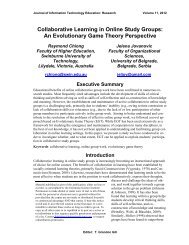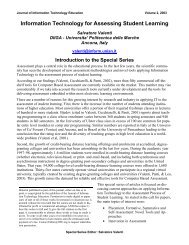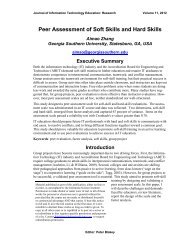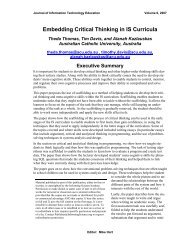Does Math Achievement h'APP'en when iPads and Game-Based ...
Does Math Achievement h'APP'en when iPads and Game-Based ...
Does Math Achievement h'APP'en when iPads and Game-Based ...
You also want an ePaper? Increase the reach of your titles
YUMPU automatically turns print PDFs into web optimized ePapers that Google loves.
The Impact of <strong>iPads</strong> on <strong>Math</strong> <strong>Achievement</strong><br />
learning using the SFAW fifth-grade textbook series during this experiment. Teachers focused<br />
instruction within the six mathematical str<strong>and</strong>s using the district’s benchmarks as a pacing guide.<br />
Both participating teachers followed the district’s fifth-grade mathematics benchmarks covering<br />
the remaining instructional content from the fifth-grade mathematics 2009 curriculum including<br />
(a) fraction concepts, (b) fraction operations, (c) measurement, (d) integers, <strong>and</strong> (e) equations.<br />
The participating teachers’ lesson plans were collected for the duration of the study. The researcher<br />
compared the lesson plans to the instructional methods used throughout the study. The<br />
lesson plans were used to gain additional insight into what actually occurred instructionally the<br />
classroom. Participating teachers were asked to complete the Lesson Plan Accuracy Rubric<br />
(LPAR) daily (see Appendix). The LPAR was distributed to several experienced colleagues to<br />
check the instrument for validity. This instrument served as a diary to record any deviations from<br />
the submitted lessons plans. External events that were not under the teacher’s control might have<br />
interfered with the implementing of a lesson such as fire drill or assemblies. To accurately<br />
document the delivery of the intervention <strong>and</strong> control conditions, the participating teachers completed<br />
the LPAR daily. The participating teacher recorded information about iPad usage, lesson<br />
plan implementation, external events or circumstances, <strong>and</strong> additional related notes. The LPAR<br />
was totaled at the end of each week to determine the overall accuracy of the lesson plan implementation.<br />
The posttest occurred after the iPad intervention. Participating students’ posttest scores on the<br />
fifth-grade mathematics SFAW Virginia SOL aligned assessment were used to measure mathematics<br />
achievement. According to Bebell et al. (2010), “well developed aligned assessments likely<br />
resulted in more reliable scores <strong>and</strong> provide increased validity for inferences about the impacts<br />
of technology” (p. 44).<br />
Results<br />
The data were screened through a variety of tests. In Table 1 the descriptive statistics were processed<br />
for outliers <strong>and</strong> skewness to ensure no discrepancies existed in the data, which might influence<br />
the results. The descriptive statistics in Table 1 indicate 104 participating students with 48<br />
students in the control group without iPad usage <strong>and</strong> 56 students in the experimental group with<br />
iPad usage. All 104 students participated in the SFAW pretest <strong>and</strong> posttest assessment.<br />
A one-way repeated measures ANOVA was appropriate for the study because the design involved<br />
a treatment factor <strong>and</strong> a time factor. The treatment (iPad <strong>and</strong> non iPad) represented the<br />
between-subjects factor, <strong>and</strong> the time (pretest <strong>and</strong> posttest) represented the within-subjects factor.<br />
Figure 1 shows a bar graph of the pretest <strong>and</strong> posttest results of the experimental <strong>and</strong> control<br />
groups.<br />
The control group completed the pretest with a mean pretest score of 55.58%. At the end of the<br />
academic quarter, the control group had a mean posttest score of 62.25%. This is a positive difference<br />
of 6.67%. The results indicate a significant change over time from the beginning of the<br />
academic quarter to the end of the academic quarter. The experimental group completed the pretest<br />
with a mean pretest score of 61.05%, which is significantly higher than the control group.<br />
The experimental group had a mean posttest of 67.79%. This is a positive difference of 6.74%.<br />
Comparing the growth of the control group <strong>and</strong> the experimental group, a difference of 0.07%<br />
was identified. <strong>Based</strong> on the results as shown in Figure 1, not enough evidence existed to reject<br />
the null hypothesis in which it was assumed that no difference in mathematics achievement would<br />
exist between the experimental <strong>and</strong> control groups as measured by the fifth-grade mathematics<br />
SFAW Virginia SOL aligned assessment.<br />
276










